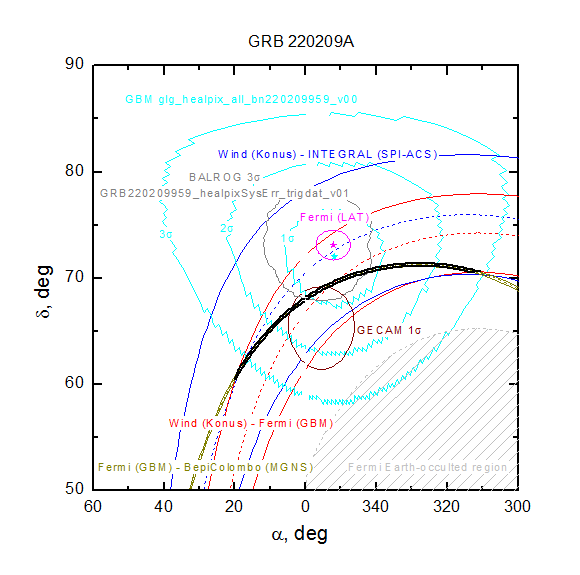(All information courtesy of the instrument teams.)
![]() Previous IAU Circulars
Previous IAU Circulars
TITLE: GCN/FERMI NOTICE
NOTICE_DATE: Wed 09 Feb 22 23:01:14 UT
NOTICE_TYPE: Fermi-GBM Flight Position
RECORD_NUM: 48
TRIGGER_NUM: 666140455
GRB_RA: 44.367d {+02h 57m 28s} (J2000),
44.884d {+02h 59m 32s} (current),
43.209d {+02h 52m 50s} (1950)
GRB_DEC: +69.683d {+69d 40' 60"} (J2000),
+69.771d {+69d 46' 15"} (current),
+69.482d {+69d 28' 56"} (1950)
GRB_ERROR: 27.33 [deg radius, statistical plus systematic]
GRB_INTEN: 68 [cnts/sec]
DATA_SIGNIF: 4.90 [sigma]
INTEG_TIME: 2.048 [sec]
GRB_DATE: 19619 TJD; 40 DOY; 22/02/09
GRB_TIME: 82850.42 SOD {23:00:50.42} UT
GRB_PHI: 50.00 [deg]
GRB_THETA: 55.00 [deg]
DATA_TIME_SCALE: 2.0480 [sec]
HARD_RATIO: 0.36
LOC_ALGORITHM: 3 (version number of)
MOST_LIKELY: 90% GRB
2nd_MOST_LIKELY: 3% Cyg X-1
DETECTORS: 1,1,1, 0,0,0, 0,0,0, 0,0,0, 0,0,
SUN_POSTN: 323.56d {+21h 34m 16s} -14.44d {-14d 26' 14"}
SUN_DIST: 100.57 [deg] Sun_angle= -5.4 [hr] (East of Sun)
MOON_POSTN: 64.20d {+04h 16m 48s} +22.03d {+22d 01' 36"}
MOON_DIST: 49.13 [deg]
MOON_ILLUM: 63 [%]
GAL_COORDS: 133.53, 9.45 [deg] galactic lon,lat of the burst (or transient)
ECL_COORDS: 67.38, 49.80 [deg] ecliptic lon,lat of the burst (or transient)
LC_URL: http://heasarc.gsfc.nasa.gov/FTP/fermi/data/gbm/triggers/2022/bn220209959/quicklook/glg_lc_medres34_bn220209959.gif
COMMENTS: Fermi-GBM Flight-calculated Coordinates.
COMMENTS: This trigger occurred at longitude,latitude = 5.38,2.63 [deg].
COMMENTS: The LC_URL file will not be created until ~15 min after the trigger.
TITLE: GCN/FERMI NOTICE
NOTICE_DATE: Wed 09 Feb 22 23:01:33 UT
NOTICE_TYPE: Fermi-GBM Flight Position
RECORD_NUM: 70
TRIGGER_NUM: 666140455
GRB_RA: 15.967d {+01h 03m 52s} (J2000),
16.353d {+01h 05m 25s} (current),
15.105d {+01h 00m 25s} (1950)
GRB_DEC: +71.500d {+71d 30' 00"} (J2000),
+71.618d {+71d 37' 06"} (current),
+71.232d {+71d 13' 54"} (1950)
GRB_ERROR: 6.30 [deg radius, statistical plus systematic]
GRB_INTEN: 474 [cnts/sec]
DATA_SIGNIF: 49.40 [sigma]
INTEG_TIME: 4.096 [sec]
GRB_DATE: 19619 TJD; 40 DOY; 22/02/09
GRB_TIME: 82850.42 SOD {23:00:50.42} UT
GRB_PHI: 41.00 [deg]
GRB_THETA: 60.00 [deg]
DATA_TIME_SCALE: 4.0960 [sec]
HARD_RATIO: 0.49
LOC_ALGORITHM: 3 (version number of)
MOST_LIKELY: 95% GRB
2nd_MOST_LIKELY: 4% Generic Transient
DETECTORS: 1,1,1, 0,0,0, 0,0,0, 0,0,0, 0,0,
SUN_POSTN: 323.57d {+21h 34m 16s} -14.44d {-14d 26' 14"}
SUN_DIST: 92.98 [deg] Sun_angle= -3.5 [hr] (East of Sun)
MOON_POSTN: 64.20d {+04h 16m 49s} +22.03d {+22d 01' 38"}
MOON_DIST: 56.49 [deg]
MOON_ILLUM: 63 [%]
GAL_COORDS: 123.93, 8.65 [deg] galactic lon,lat of the burst (or transient)
ECL_COORDS: 56.29, 56.65 [deg] ecliptic lon,lat of the burst (or transient)
LC_URL: http://heasarc.gsfc.nasa.gov/FTP/fermi/data/gbm/triggers/2022/bn220209959/quicklook/glg_lc_medres34_bn220209959.gif
COMMENTS: Fermi-GBM Flight-calculated Coordinates.
COMMENTS: This trigger occurred at longitude,latitude = 5.38,2.63 [deg].
COMMENTS: The LC_URL file will not be created until ~15 min after the trigger.
TITLE: GCN/FERMI NOTICE
NOTICE_DATE: Wed 09 Feb 22 23:01:23 UT
NOTICE_TYPE: Fermi-GBM Flight Position
RECORD_NUM: 59
TRIGGER_NUM: 666140455
GRB_RA: 351.683d {+23h 26m 44s} (J2000),
351.921d {+23h 27m 41s} (current),
351.150d {+23h 24m 36s} (1950)
GRB_DEC: +68.867d {+68d 52' 00"} (J2000),
+68.989d {+68d 59' 19"} (current),
+68.591d {+68d 35' 29"} (1950)
GRB_ERROR: 10.62 [deg radius, statistical plus systematic]
GRB_INTEN: 294 [cnts/sec]
DATA_SIGNIF: 16.60 [sigma]
INTEG_TIME: 1.024 [sec]
GRB_DATE: 19619 TJD; 40 DOY; 22/02/09
GRB_TIME: 82850.42 SOD {23:00:50.42} UT
GRB_PHI: 33.00 [deg]
GRB_THETA: 65.00 [deg]
DATA_TIME_SCALE: 1.0240 [sec]
HARD_RATIO: 0.46
LOC_ALGORITHM: 3 (version number of)
MOST_LIKELY: 91% GRB
2nd_MOST_LIKELY: 4% Generic Transient
DETECTORS: 1,1,1, 0,0,0, 0,0,0, 0,0,0, 0,0,
SUN_POSTN: 323.57d {+21h 34m 16s} -14.44d {-14d 26' 14"}
SUN_DIST: 85.82 [deg] Sun_angle= -1.9 [hr] (East of Sun)
MOON_POSTN: 64.20d {+04h 16m 48s} +22.03d {+22d 01' 37"}
MOON_DIST: 63.17 [deg]
MOON_ILLUM: 63 [%]
GAL_COORDS: 115.39, 7.24 [deg] galactic lon,lat of the burst (or transient)
ECL_COORDS: 42.17, 61.23 [deg] ecliptic lon,lat of the burst (or transient)
LC_URL: http://heasarc.gsfc.nasa.gov/FTP/fermi/data/gbm/triggers/2022/bn220209959/quicklook/glg_lc_medres34_bn220209959.gif
COMMENTS: Fermi-GBM Flight-calculated Coordinates.
COMMENTS: This trigger occurred at longitude,latitude = 5.38,2.63 [deg].
COMMENTS: The LC_URL file will not be created until ~15 min after the trigger.
TITLE: GCN/FERMI NOTICE
NOTICE_DATE: Wed 09 Feb 22 23:01:31 UT
NOTICE_TYPE: Fermi-GBM Ground Position
RECORD_NUM: 58
TRIGGER_NUM: 666140455
GRB_RA: 21.390d {+01h 25m 34s} (J2000),
21.778d {+01h 27m 07s} (current),
20.522d {+01h 22m 05s} (1950)
GRB_DEC: +66.530d {+66d 31' 48"} (J2000),
+66.644d {+66d 38' 40"} (current),
+66.270d {+66d 16' 12"} (1950)
GRB_ERROR: 14.50 [deg radius, statistical only]
DATA_SIGNIF: 6.10 [sigma]
DATA_INTERVAL: 4.096 [sec]
GRB_DATE: 19619 TJD; 40 DOY; 22/02/09
GRB_TIME: 82850.42 SOD {23:00:50.42} UT
GRB_PHI: 45.00 [deg]
GRB_THETA: 63.00 [deg]
E_RANGE: 44.032 - 279.965 [keV]
LOC_ALGORITHM: 4173 (Gnd S/W Version number)
SUN_POSTN: 323.57d {+21h 34m 16s} -14.44d {-14d 26' 14"}
SUN_DIST: 91.53 [deg] Sun_angle= -3.9 [hr] (East of Sun)
MOON_POSTN: 64.20d {+04h 16m 48s} +22.03d {+22d 01' 38"}
MOON_DIST: 52.01 [deg]
MOON_ILLUM: 63 [%]
GAL_COORDS: 126.33, 3.88 [deg] galactic lon,lat of the burst (or transient)
ECL_COORDS: 53.33, 51.61 [deg] ecliptic lon,lat of the burst (or transient)
LC_URL: http://heasarc.gsfc.nasa.gov/FTP/fermi/data/gbm/triggers/2022/bn220209959/quicklook/glg_lc_medres34_bn220209959.gif
POS_MAP_URL: http://gcn.gsfc.nasa.gov/notices_f/gbm_gnd_loc_map_666140455.fits
COMMENTS: Fermi-GBM Ground-calculated Coordinates.
COMMENTS: This Notice was ground-generated -- not flight-generated.
COMMENTS: The LC_URL file will not be created/available until ~15 min after the trigger.
COMMENTS: The POS_MAP_URL file will not be created/available until ~1.5 min after the notice.
TITLE: GCN/FERMI NOTICE
NOTICE_DATE: Wed 09 Feb 22 23:02:25 UT
NOTICE_TYPE: Fermi-GBM Ground Position
RECORD_NUM: 0
TRIGGER_NUM: 666140455
GRB_RA: 356.060d {+23h 44m 14s} (J2000),
356.320d {+23h 45m 17s} (current),
355.477d {+23h 41m 54s} (1950)
GRB_DEC: +70.490d {+70d 29' 24"} (J2000),
+70.613d {+70d 36' 46"} (current),
+70.212d {+70d 12' 44"} (1950)
GRB_ERROR: 5.90 [deg radius, statistical only]
DATA_SIGNIF: 13.20 [sigma]
DATA_INTERVAL: 7.168 [sec]
GRB_DATE: 19619 TJD; 40 DOY; 22/02/09
GRB_TIME: 82850.42 SOD {23:00:50.42} UT
GRB_PHI: 34.00 [deg]
GRB_THETA: 63.00 [deg]
E_RANGE: 44.032 - 279.965 [keV]
LOC_ALGORITHM: 41731 (Gnd S/W Version number)
SUN_POSTN: 323.57d {+21h 34m 16s} -14.44d {-14d 26' 13"}
SUN_DIST: 87.98 [deg] Sun_angle= -2.2 [hr] (East of Sun)
MOON_POSTN: 64.21d {+04h 16m 50s} +22.03d {+22d 01' 45"}
MOON_DIST: 61.99 [deg]
MOON_ILLUM: 63 [%]
GAL_COORDS: 117.33, 8.35 [deg] galactic lon,lat of the burst (or transient)
ECL_COORDS: 46.73, 60.92 [deg] ecliptic lon,lat of the burst (or transient)
LC_URL: http://heasarc.gsfc.nasa.gov/FTP/fermi/data/gbm/triggers/2022/bn220209959/quicklook/glg_lc_medres34_bn220209959.gif
POS_MAP_URL: http://gcn.gsfc.nasa.gov/notices_f/gbm_gnd_loc_map_666140455.fits
COMMENTS: Fermi-GBM Ground-calculated Coordinates.
COMMENTS: Bright hard burst in the GBM.
COMMENTS: This is likely a Long GRB.
COMMENTS: This Notice was ground-generated -- not flight-generated.
COMMENTS: The LC_URL file will not be created/available until ~15 min after the trigger.
COMMENTS: The POS_MAP_URL file will not be created/available until ~1.5 min after the notice.
COMMENTS:
COMMENTS: NOTE: This GBM event is temporally(7.0<100sec) coincident with the CALET_GBM event (trignum=1328482817).
TITLE: GCN/FERMI NOTICE
NOTICE_DATE: Wed 09 Feb 22 23:02:36 UT
NOTICE_TYPE: Fermi-GBM Ground Position
RECORD_NUM: 2
TRIGGER_NUM: 666140455
GRB_RA: 354.180d {+23h 36m 43s} (J2000),
354.424d {+23h 37m 42s} (current),
353.634d {+23h 34m 32s} (1950)
GRB_DEC: +72.750d {+72d 45' 00"} (J2000),
+72.872d {+72d 52' 21"} (current),
+72.473d {+72d 28' 23"} (1950)
GRB_ERROR: 1.53 [deg radius, statistical only]
DATA_SIGNIF: 38.50 [sigma]
DATA_INTERVAL: 10.240 [sec]
GRB_DATE: 19619 TJD; 40 DOY; 22/02/09
GRB_TIME: 82850.42 SOD {23:00:50.42} UT
GRB_PHI: 33.00 [deg]
GRB_THETA: 61.00 [deg]
E_RANGE: 44.032 - 279.965 [keV]
LOC_ALGORITHM: 41731 (Gnd S/W Version number)
SUN_POSTN: 323.57d {+21h 34m 16s} -14.44d {-14d 26' 13"}
SUN_DIST: 89.62 [deg] Sun_angle= -2.1 [hr] (East of Sun)
MOON_POSTN: 64.21d {+04h 16m 51s} +22.03d {+22d 01' 46"}
MOON_DIST: 63.08 [deg]
MOON_ILLUM: 63 [%]
GAL_COORDS: 117.39, 10.69 [deg] galactic lon,lat of the burst (or transient)
ECL_COORDS: 50.06, 62.64 [deg] ecliptic lon,lat of the burst (or transient)
LC_URL: http://heasarc.gsfc.nasa.gov/FTP/fermi/data/gbm/triggers/2022/bn220209959/quicklook/glg_lc_medres34_bn220209959.gif
POS_MAP_URL: http://gcn.gsfc.nasa.gov/notices_f/gbm_gnd_loc_map_666140455.fits
COMMENTS: Fermi-GBM Ground-calculated Coordinates.
COMMENTS: Bright hard burst in the GBM.
COMMENTS: This is likely a Long GRB.
COMMENTS: This Notice was ground-generated -- not flight-generated.
COMMENTS: The LC_URL file will not be created/available until ~15 min after the trigger.
COMMENTS: The POS_MAP_URL file will not be created/available until ~1.5 min after the notice.
COMMENTS:
COMMENTS: NOTE: This GBM event is temporally(7.0<100sec) coincident with the CALET_GBM event (trignum=1328482817).
TITLE: GCN/FERMI NOTICE
NOTICE_DATE: Wed 09 Feb 22 23:02:55 UT
NOTICE_TYPE: Fermi-GBM Ground Position
RECORD_NUM: 4
TRIGGER_NUM: 666140455
GRB_RA: 355.860d {+23h 43m 26s} (J2000),
356.117d {+23h 44m 28s} (current),
355.284d {+23h 41m 08s} (1950)
GRB_DEC: +71.680d {+71d 40' 48"} (J2000),
+71.803d {+71d 48' 10"} (current),
+71.402d {+71d 24' 09"} (1950)
GRB_ERROR: 1.17 [deg radius, statistical only]
DATA_SIGNIF: 54.40 [sigma]
DATA_INTERVAL: 15.360 [sec]
GRB_DATE: 19619 TJD; 40 DOY; 22/02/09
GRB_TIME: 82850.42 SOD {23:00:50.42} UT
GRB_PHI: 34.00 [deg]
GRB_THETA: 62.00 [deg]
E_RANGE: 44.032 - 279.965 [keV]
LOC_ALGORITHM: 41731 (Gnd S/W Version number)
SUN_POSTN: 323.57d {+21h 34m 16s} -14.44d {-14d 26' 13"}
SUN_DIST: 88.96 [deg] Sun_angle= -2.2 [hr] (East of Sun)
MOON_POSTN: 64.21d {+04h 16m 51s} +22.03d {+22d 01' 48"}
MOON_DIST: 62.33 [deg]
MOON_ILLUM: 63 [%]
GAL_COORDS: 117.59, 9.52 [deg] galactic lon,lat of the burst (or transient)
ECL_COORDS: 48.70, 61.64 [deg] ecliptic lon,lat of the burst (or transient)
LC_URL: http://heasarc.gsfc.nasa.gov/FTP/fermi/data/gbm/triggers/2022/bn220209959/quicklook/glg_lc_medres34_bn220209959.gif
POS_MAP_URL: http://gcn.gsfc.nasa.gov/notices_f/gbm_gnd_loc_map_666140455.fits
COMMENTS: Fermi-GBM Ground-calculated Coordinates.
COMMENTS: Bright hard burst in the GBM.
COMMENTS: This is likely a Long GRB.
COMMENTS: This Notice was ground-generated -- not flight-generated.
COMMENTS: The LC_URL file will not be created/available until ~15 min after the trigger.
COMMENTS: The POS_MAP_URL file will not be created/available until ~1.5 min after the notice.
COMMENTS:
COMMENTS: NOTE: This GBM event is temporally(7.0<100sec) coincident with the CALET_GBM event (trignum=1328482817).
TITLE: GCN/FERMI NOTICE
NOTICE_DATE: Wed 09 Feb 22 23:10:07 UT
NOTICE_TYPE: Fermi-GBM Final Position
RECORD_NUM: 0
TRIGGER_NUM: 666140455
GRB_RA: 352.270d {+23h 29m 05s} (J2000),
352.503d {+23h 30m 01s} (current),
351.748d {+23h 26m 59s} (1950)
GRB_DEC: +72.020d {+72d 01' 12"} (J2000),
+72.142d {+72d 08' 31"} (current),
+71.744d {+71d 44' 39"} (1950)
GRB_ERROR: 1.00 [deg radius, statistical only]
GRB_DATE: 19619 TJD; 40 DOY; 22/02/09
GRB_TIME: 82850.42 SOD {23:00:50.42} UT
GRB_PHI: 33.00 [deg]
GRB_THETA: 62.00 [deg]
E_RANGE: 44.032 - 279.965 [keV]
LOC_ALGORITHM: 41731 (Gnd S/W Version number)
SUN_POSTN: 323.57d {+21h 34m 17s} -14.44d {-14d 26' 07"}
SUN_DIST: 88.70 [deg] Sun_angle= -1.9 [hr] (East of Sun)
MOON_POSTN: 64.28d {+04h 17m 06s} +22.05d {+22d 02' 43"}
MOON_DIST: 63.50 [deg]
MOON_ILLUM: 63 [%]
GAL_COORDS: 116.60, 10.17 [deg] galactic lon,lat of the burst (or transient)
ECL_COORDS: 48.05, 62.77 [deg] ecliptic lon,lat of the burst (or transient)
LC_URL: http://heasarc.gsfc.nasa.gov/FTP/fermi/data/gbm/triggers/2022/bn220209959/quicklook/glg_lc_medres34_bn220209959.gif
LOC_URL: http://heasarc.gsfc.nasa.gov/FTP/fermi/data/gbm/triggers/2022/bn220209959/quicklook/glg_locplot_all_bn220209959.png
COMMENTS: Fermi-GBM Final Position.
COMMENTS: This Notice was ground-generated -- not flight-generated.
COMMENTS: The LC_URL file should be available by the time this FINAL notice is produced.
COMMENTS: This notice was generated completely by automated pipeline processing.
COMMENTS: Bright hard burst in the GBM.
COMMENTS: This is likely a Long GRB.
COMMENTS:
COMMENTS: NOTE: This GBM event is temporally(7.0<100sec) coincident with the CALET_GBM event (trignum=1328482817).
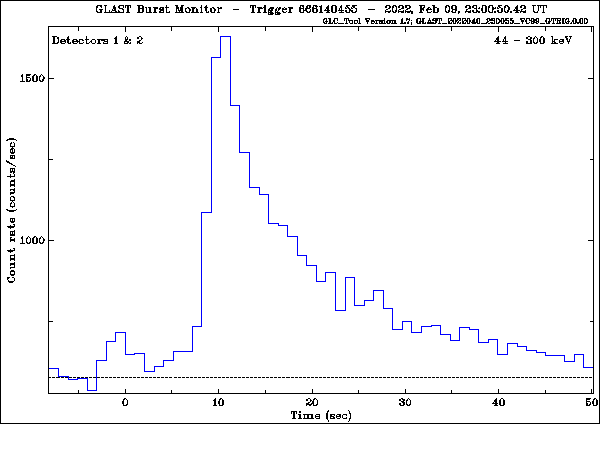
Tmid-T0 | Date Time | Site | Coord (J2000) |Filt.| Expt. | Limit| Comment _________|_____________________|_____________________|____________________________________|_____|_______|_______|________ 28734 | 2022-02-10 06:59:14 | MASTER-IAC | (23h 47m 25.56s , +69d 30m 47.3s) | C | 60 | 13.9 | 38656 | 2022-02-10 09:44:35 | MASTER-Amur | (23h 01m 26.56s , +71d 09m 13.9s) | C | 60 | 14.3 | 38735 | 2022-02-10 09:45:55 | MASTER-Amur | (23h 26m 44.90s , +71d 10m 06.6s) | C | 60 | 14.6 | 38815 | 2022-02-10 09:47:15 | MASTER-Amur | (23h 49m 22.42s , +71d 09m 55.0s) | C | 60 | 14.6 |Filter C is a clear (unfiltred) band.
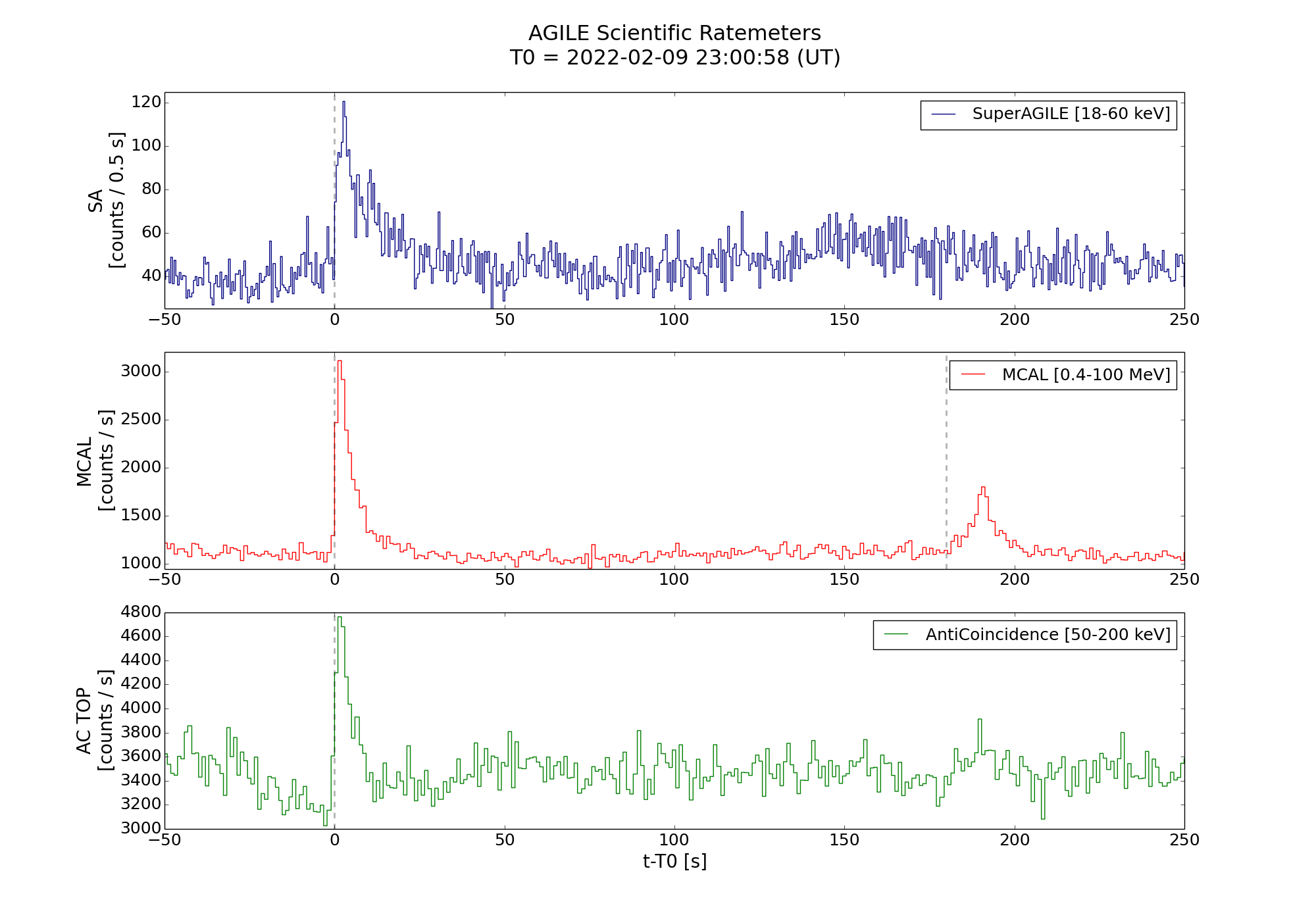
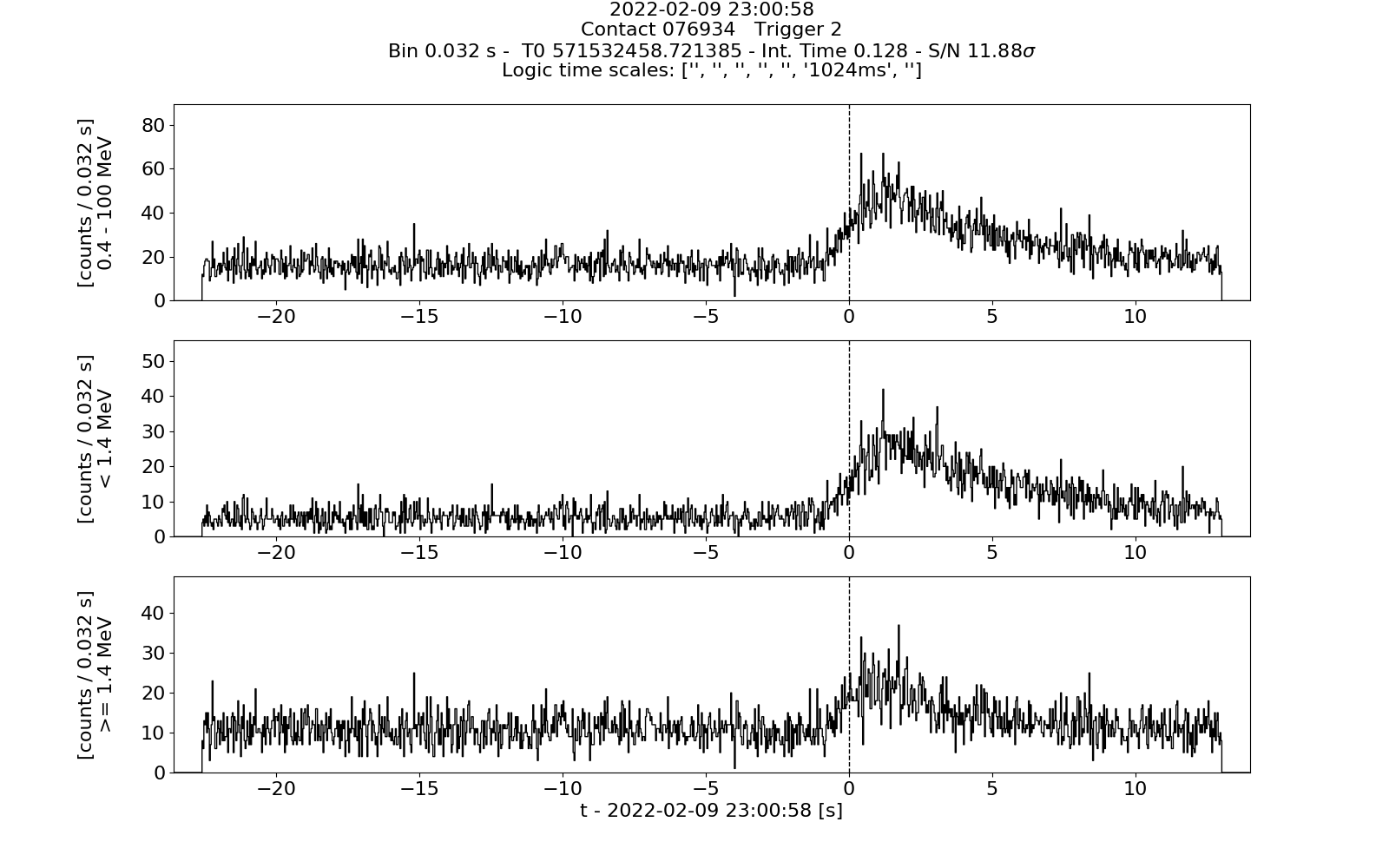

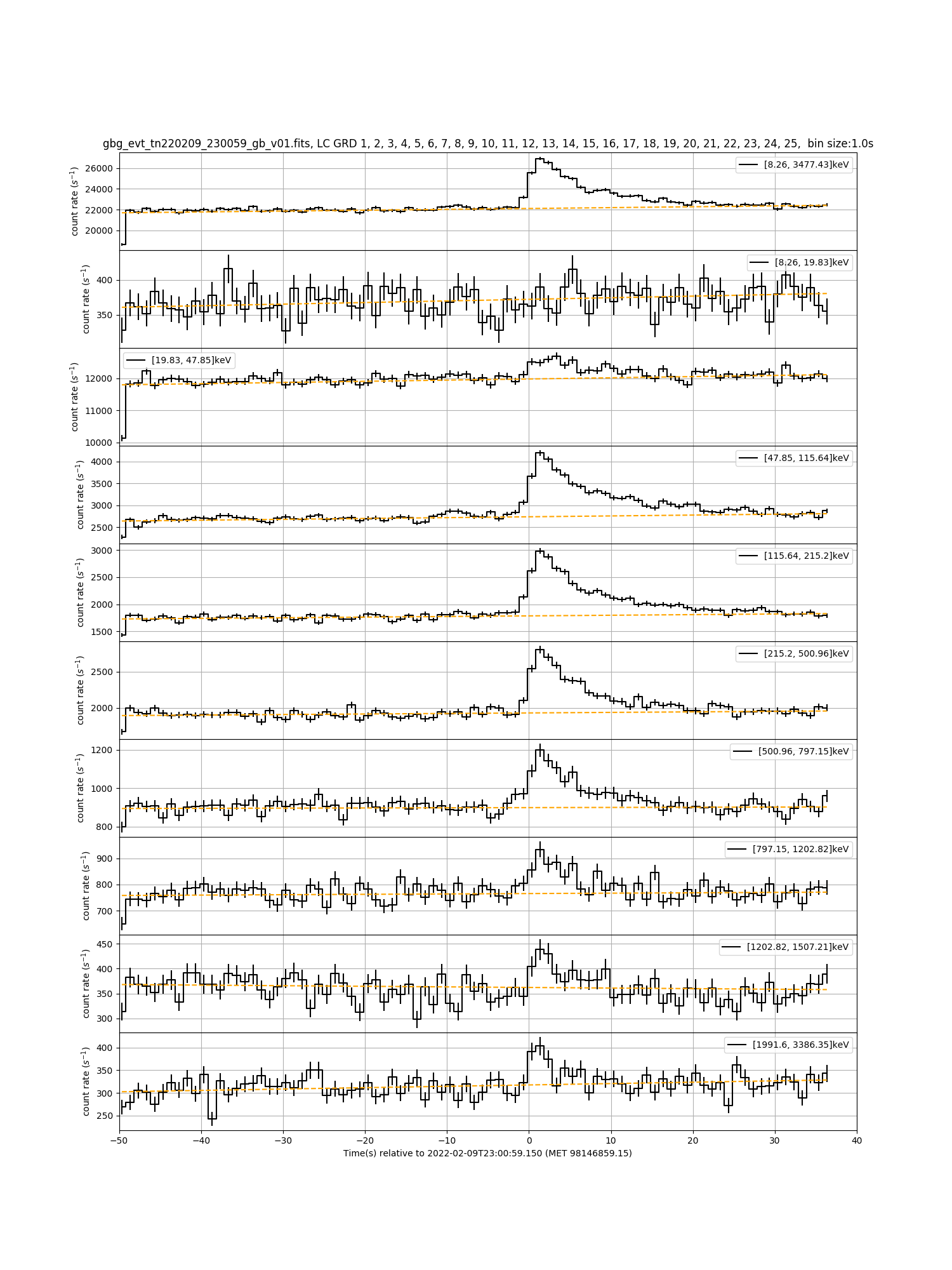
---------------------------------------------
RA(2000), deg Dec(2000), deg
---------------------------------------------
Center:
351.998 (23h 28m 00s) +69.556 (+69d 33' 22")
Corners:
19.772 (01h 19m 05s) +60.497 (+60d 29' 49")
18.826 (01h 15m 18s) +61.426 (+61d 25' 34")
310.634 (20h 42m 32s) +70.589 (+70d 35' 21")
313.447 (20h 53m 47s) +70.575 (+70d 34' 31")
---------------------------------------------
The error box area is 7.1 sq. deg, and its maximum
dimension is 28.4 deg (the minimum one is 15.5 arcmin).
The Sun distance was 85 deg.
